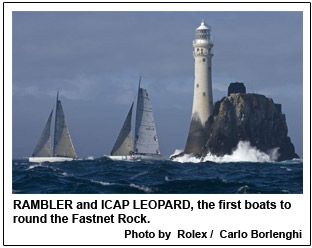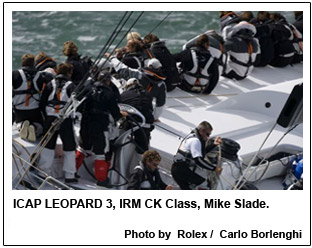| A Full House For Rolex Fastnet Race
July 16, 2009

A sound guide to the success of any yacht race is when the entry limit is exceeded. Once again the Royal Ocean Racing Club has managed this with their biennial flagship event, the Rolex Fastnet Race, where the 300 boat maximum has been comfortably reached.
The make-up of this year's Rolex Fastnet Race fleet is one of the most international ever with entries from 16 countries. While the UK and France comprise the majority, this year the line-up includes boats from as far afield as Australia, with the much-travelled Rolex Sydney Hobart entrant Berrimilla 2, sailed by Alex Whitworth and Peter Crozier, to the Chilean Class 40, Desafio Cabo de Hornos, recently second round the world in the Portimao Global Ocean Race, to Karl Kwok's Beau Geste from Hong Kong. A number of boats are also making the journey all the way to the start in Cowes from the US, such as Roger Sturgeon's Rolex Sydney Hobart-winning STP65 Rosebud/Team DYT, or up from the Mediterranean, such as the Italian America's Cup team Luna Rossa with their STP65 led by four-time Olympic medallist, Robert Scheidt.
The line-up this year is as spectacular, as it is diverse, with a huge spread of boats, from the 100 footers - Mike Slade's line honours hunting ICAP Leopard, and the more comfortable Performance Yachts 100, Liara of Tony Todd - down to the smallest class 3 yachts, the shortest being the Polish 30-footer, Four Winds, belonging to Wieslaw Krupski.
The RORC's IRC handicap system is used to level out the widely differing performances found across this range of boats as best indicated by their IRC time correction factors: Leopard's stands at 1.868, while Tony Harwood's comfortable Nicholson 38 Volante is the lowest rated boat entered with a TCF of 0.863. This means that to beat Volante, Leopard has to sail 2.16 times faster than her or when Leopard crosses the finish line, Volante could still be ahead of her if she were only half way across the Celtic Sea outbound to the Fastnet Rock with more than 325 miles of the 608-mile long race still left to sail.
With such a large fleet, the boats are divided up into classes: SZ, Z, 1, 2 and 3 with a special class SZCK, for the canting keel yachts such as ICAP Leopard and the Open 60s such as Alex Thomson's Hugo Boss. In addition, one of the most competitive classes this year will be the Class 40 of which 20 examples are racing, including Giovanni Soldini's Telecom Italia, winner of last year's Artemis Transat.
One of the favourites for the overall handicap prize is certain to be Dutch skipper Piet Vroon and his new Ker 46, Tonnerre de Breskens. Launched this season, Tonnerre has already won two of the three of the RORC races she has entered.
"It has been going very well. I am rather pleased!" says her Dutch owner enthusiastically. Vroon cannot remember exactly how many Rolex Fastnet Races he has done, but thinks the number is around 21. This includes winning overall in 2001, although he admits he followed this up two years later with a 237th place. "It is the only offshore race left. All the other ones are just overnight," he says as to the attraction of the race. "The course is interesting and difficult. It is not all that easy to predict where you have got to be. In spite of all the electronics and weather information, it always works out slightly different from what you expect. Like in 2001, if you happen to get it all right - if you pass Portland at the right moment, Land's End, if you catch the tides right, if the wind changes your way - by the same token, if you miss it by half an hour you can be out."
Typically small boats do well when the race starts light and conditions build mid-week. In recent history the  best example of this was when Jean Yves Chateau's well-sailed Nicholson 33, Iromiguy won overall in 2005. "For me it is the greatest race in Europe," says Chateau of the Rolex Fastnet Race. "There are many, many beautiful racing boats and we very much like this race. I have known this race for a very, very long time. When I was a child it was a dream to do this race, and for me when we won this race four years ago, it was extraordinaire!" best example of this was when Jean Yves Chateau's well-sailed Nicholson 33, Iromiguy won overall in 2005. "For me it is the greatest race in Europe," says Chateau of the Rolex Fastnet Race. "There are many, many beautiful racing boats and we very much like this race. I have known this race for a very, very long time. When I was a child it was a dream to do this race, and for me when we won this race four years ago, it was extraordinaire!"
Chateau returns this year with just one crew change. Already this year he has been warming up by competing in the RORC's races and at present lies ninth overall in the RORC 2009 championship.
At the bigger end of the spectrum, the race favourite is probably Niklas Zennström's new Judel Vrolijk 72 Ran 2 that has already had a successful season in the Mediterranean. She also benefits from local knowledge having a largely British crew, led by Volvo Ocean Race veteran Tim Powell.
While winning the Rolex Fastnet Race comes down to how well each of the entries sails relative to their rating, many additional wildcards are thrown at the competitors from, in particular, the weather, but also tides and the numerous tidal 'gates' off every headland along the south coast of England. This is what makes this race one of the most tactical games of snakes and ladders in the yachting calendar.
One advantage of having a bigger boat is that they are less affected by these tidal gates than the smaller boats, as Tim Powell explains: "With all these kind of races you need an element of good fortune to make it through the tide gates smoothly. The one thing about our boat is that it doesn't take a lot of wind to get going and get a decent speed up - whereas the smaller boats might struggle to get through a tide gate if there's only 5 knots of wind. In that we'd keep on punching through. I am a firm believer that you need a bit of good fortune with the tides stacking up right for you. But that's something you can't control too much. You end up where you end up."
Ran 2 will sail with her normal all-star cast including numerous America's Cup and Volvo Ocean Race veterans but they will face the very highest competition with crews of equally accomplished sailors on board the STP65s Rosebud and Luna Rossa and on Karl Kwok's Farr 80 Beau Geste. Powell says he will be particularly looking out for Rosebud and Beau Geste as they are the more offshore-orientated.
Once again the Rolex Fastnet Race boats will be fitted with tracking units and a new feature this year is that at the finish the boats will moor in Sutton Harbour, rather than Queen Anne's Battery. Sutton Harbour is right next to the Barbican, Plymouth's most lively district and has enough draft to allow all the boats to berth there, with the exception of the Open 60s fitted with deck spreaders that are too wide to get through the lock.
Another new addition this year is a virtual race game on the RORC Rolex Fastnet Race minisite fastnet.rorc.org. Armchair sailors around the world will be able to test their skills against the 2,500 competitors racing on 300 yachts, with the launch of a Virtual Rolex Fastnet Game developed by Virtual Regatta.com. The game is free to play and is designed to be as close as possible to the real thing.
The first signal for the start of the 2009 Rolex Fastnet Race sounds at 11.50 BST on Sunday, 9 August.
Further information about the RORC and the Rolex Fastnet Race including a provisional entry list may be found at fastnet.rorc.org and competitors are encouraged to keep a close eye on these web pages since all administrative documentation and race notices will be posted there.
TOP
|